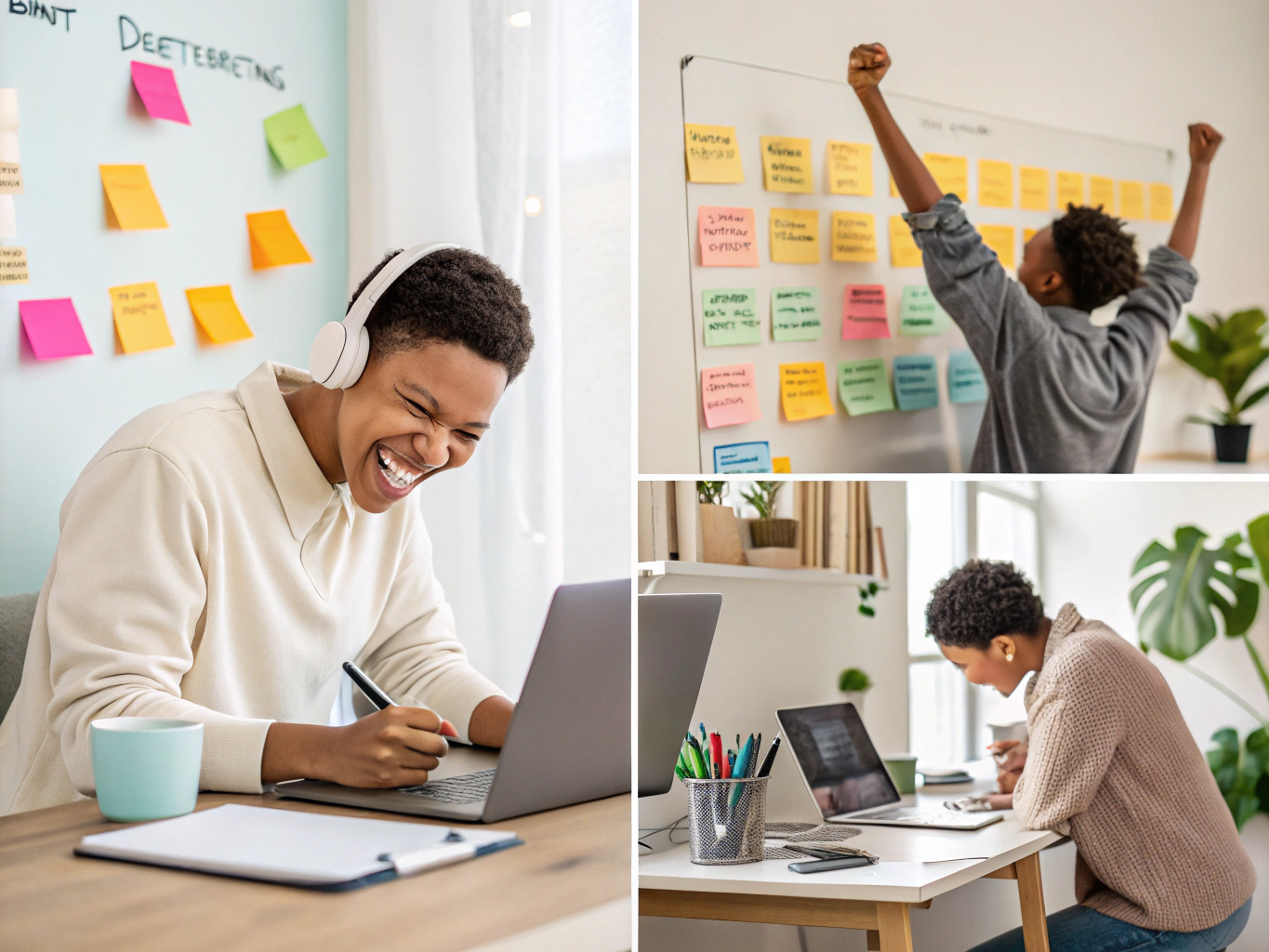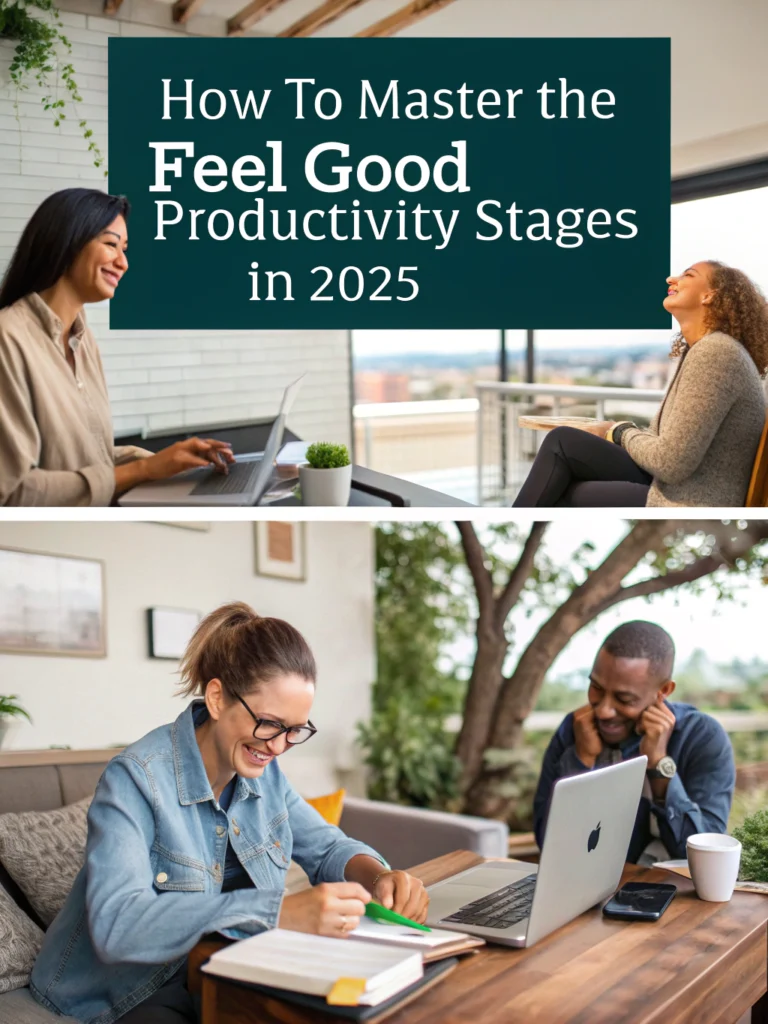Understanding Feel Good Productivity in 2025
Feel good productivity isn't just another buzzword—it's a sustainable approach to getting things done that aligns with your natural energy cycles and values. Unlike traditional productivity methods that focus solely on output, this approach prioritizes both results and your mental wellbeing.
The key to mastering productivity stages lies in understanding that productivity isn't a constant state but rather a series of interconnected phases that flow naturally from one to another.
The Four Feel Good Productivity Stages
1. Vision & Planning
The first stage is about clarity and intention. Before diving into tasks, take time to:
- Define what success looks like for you personally
- Align your goals with your core values
- Create a roadmap that excites rather than overwhelms you
In 2025, tools like vision boards and AI-powered planning assistants will make this stage more accessible than ever. The >AI for Productivity eBook + Checklist: Supercharge Your Efficiency in 2189 provides cutting-edge strategies for leveraging technology during this crucial phase.
2. Flow & Implementation
This is where the magic happens—getting into that state of deep, focused work where time seems to disappear. To master this stage:
- Create environment triggers that signal "it's time to work"
- Batch similar tasks to minimize context switching
- Use time-blocking techniques that match your natural energy patterns
How to be productive in 2025 largely depends on protecting these flow states from the endless distractions of modern life. Consider implementing dedicated deep work hours with all notifications turned off.

3. Reflection & Iteration
What separates truly productive people from busy people is this critical third stage. After completing work sessions:
- Review what went well and what didn't
- Identify patterns in your productivity highs and lows
- Make small adjustments to your approach
This reflective practice is the cornerstone of feel good work strategies. It transforms productivity from a rigid system into an evolving, personalized approach that gets better over time.
4. Recovery & Renewal
Perhaps the most overlooked yet vital stage in the productivity stages 2025 framework is intentional recovery. This includes:
- Scheduling deliberate breaks between focused work sessions
- Engaging in activities that replenish your mental energy
- Creating clear boundaries between work and personal time
Research consistently shows that proper recovery doesn't just prevent burnout—it actually enhances creativity and problem-solving abilities. To truly boost productivity and well-being, you must embrace this stage rather than see it as "non-productive" time.
Implementing Feel Good Productivity in Your Daily Life
Putting these stages into practice requires both structure and flexibility. Here's a practical framework:
Morning Routine: Vision Setting (15-30 minutes)
- Review your goals and priorities
- Plan your day according to energy levels, not just time
- Set intentions for how you want to feel during the day
Deep Work Blocks (60-90 minutes each)
- Turn off all notifications
- Use a timer to work in focused sprints
- Take short breaks between blocks
Those with attention challenges should check out the >ADHD Productivity Power Pack: Ebooks, Guides, Checklists, Workbook & Tools to Master Focus, Time Management & Organization which offers specialized techniques for maintaining focus.
End-of-Day Reflection (10 minutes)
- Note your wins, no matter how small
- Identify what drained or energized you
- Adjust tomorrow's plan based on today's insights
Technology and Tools for Feel Good Productivity
The right tools can significantly enhance your productivity journey. In 2025, these tools should:
- Work seamlessly across devices
- Reduce friction rather than add complexity
- Support your wellbeing through features like break reminders
Some recommended tools include:
- Smart time-tracking apps that suggest optimal work times based on your past performance
- Desktop backgrounds designed to inspire focus and calm
- One-page productivity templates that simplify planning
- Energy management tools that help you track your mental resources
Personal Growth Tips for 2025
As we navigate 2025, these personal growth tips 2025 will help you stay ahead:
- Embrace "productive imperfection" — progress over perfection
- Incorporate micro-learning into your daily routine
- Practice singular focus in an increasingly multi-tasking world
- Develop digital minimalism to combat information overload
Common Obstacles to Feel Good Productivity
Even with the best intentions, you'll face challenges in your productivity journey. Here are solutions to common roadblocks:
Challenge: Digital distractions
Solution: Use app blockers during focused work time and create designated "distraction zones" for specified times of day.
Challenge: Perfectionism
Solution: Set "good enough" criteria for each task before you begin, and establish clear completion guidelines.
Challenge: Energy fluctuations
Solution: Map your natural energy patterns for a week and schedule your most demanding tasks during your peak energy periods.
Challenge: Motivation dips
Solution: Create a "why" document that connects your daily tasks to your bigger purpose and review it when motivation wanes.
FAQ About Feel Good Productivity Stages
How are the feel good productivity stages different from traditional productivity methods?
Traditional productivity methods often focus solely on output and efficiency, while feel good productivity emphasizes both results and wellbeing. The stages incorporate intentional recovery periods and reflection, making it more sustainable long-term.
How long should I spend in each productivity stage?
This varies by individual, but generally:
- Vision & Planning: 5-10% of your time
- Flow & Implementation: 60-70% of your time
- Reflection & Iteration: 10-15% of your time
- Recovery & Renewal: 15-20% of your time
Can feel good productivity work for people with ADHD or attention challenges?
Absolutely! In fact, this approach can be especially beneficial for those with attention challenges because it works with your natural rhythms rather than forcing rigid structures. The focus on wellbeing also helps manage the stress that can exacerbate attention issues.
How do I know if I'm making progress with the feel good productivity stages?
Progress indicators include: feeling less drained at the end of the day, more consistent output over time (rather than boom-and-bust cycles), increased satisfaction with your work, and improved ability to estimate how long tasks will take.
Conclusion
Mastering the feel good productivity stages in 2025 isn't about pushing yourself to the limit or following rigid systems that don't account for your humanity. Instead, it's about creating a personalized approach that honors both your capacity for achievement and your need for wellbeing.
By cycling through vision, flow, reflection, and recovery, you create a sustainable productivity engine that powers your life without burning you out. Remember that productivity is not a destination but a journey—one that should feel good along the way.
Are you ready to transform your relationship with productivity and embrace the feel good productivity stages in 2025?

